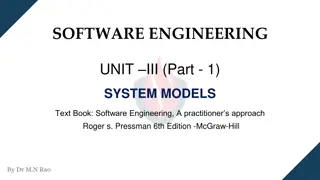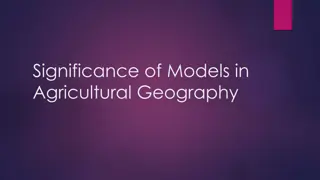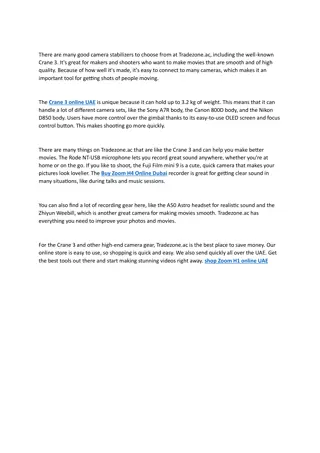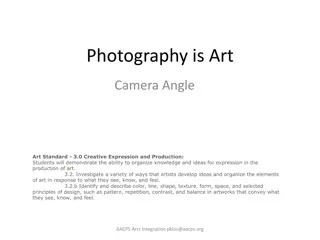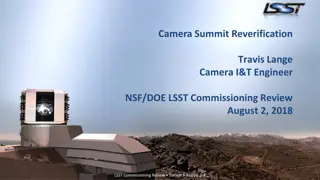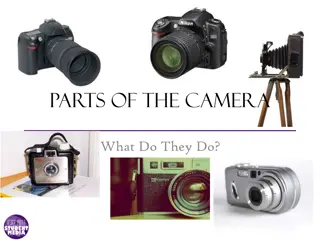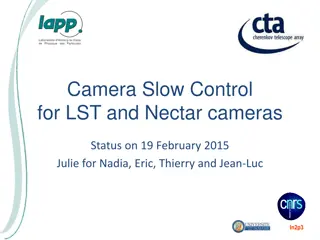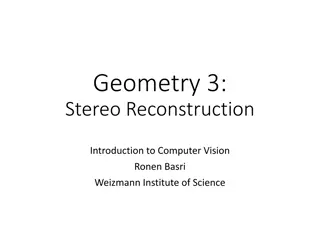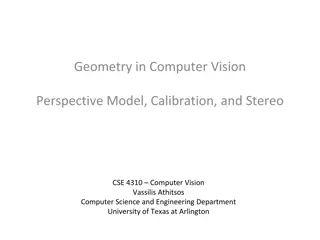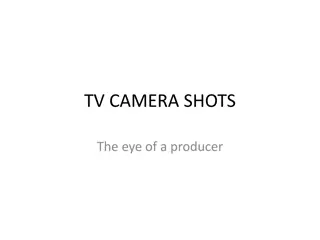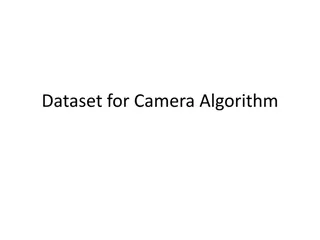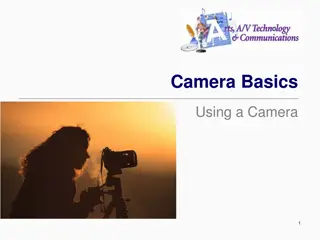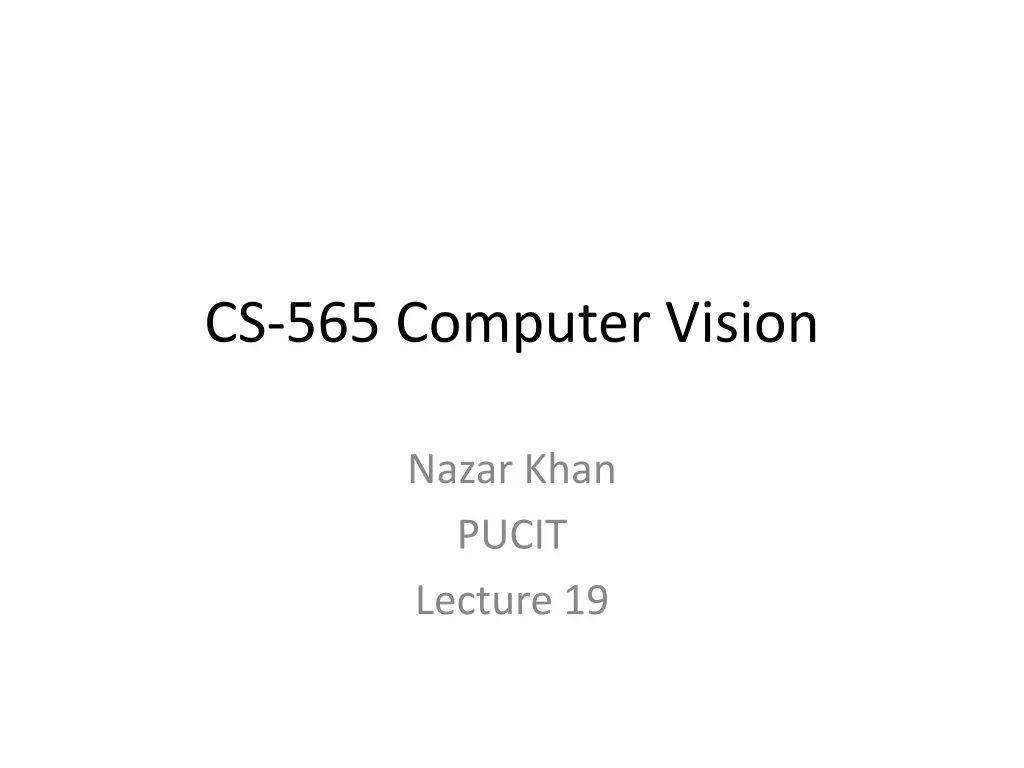
Understanding Camera Projection in Computer Vision
Explore the concepts of camera projection in computer vision, including the pinhole camera model and how 3D world points are transformed into 2D pixel coordinates. Delve into the process of extracting information from 2D images about a 3D world and the motivation behind this central goal of computer vision.
Download Presentation

Please find below an Image/Link to download the presentation.
The content on the website is provided AS IS for your information and personal use only. It may not be sold, licensed, or shared on other websites without obtaining consent from the author. If you encounter any issues during the download, it is possible that the publisher has removed the file from their server.
You are allowed to download the files provided on this website for personal or commercial use, subject to the condition that they are used lawfully. All files are the property of their respective owners.
The content on the website is provided AS IS for your information and personal use only. It may not be sold, licensed, or shared on other websites without obtaining consent from the author.
E N D
Presentation Transcript
CS-565 Computer Vision Nazar Khan PUCIT Lecture 19
Announcement Talk on Image Restoration Friday 2:30 pm, Al-Khwarzmi Lecture Theater All of you should attend!
Motivation One central goal of computer vision is to extract information about a 3-D world from 2-D images. To understand this mechanism, we first have to investigate how 2-D images arise from a 3-D world. First we consider a single camera (monocular vision). Usually the imaging process is modelled with the so- called pinhole camera model. This requires some single view projective geometry. More advanced situations such as two cameras (binocular vision, stereo vision) and the corresponding epipolar geometry will be treated in the next lecture.
Camera A camera projects 3D world points to 2D pixel coordinates. In this lecture, we study the whole process of going from 3D world coordinates to 2D image pixel coordinates. Summary: The whole process can be encoded in a 3x4 camera projection matrix P. x=PX where x is the 2D pixel location of the 3D world point X when projected by camera P.
Pinhole Camera A dark box with just a small hole. No lens. Light from the scene passes through the pinhole and projects an inverted image of the scene on the side opposite to the pinhole. Source: http://en.wikipedia.org/wiki/Pinhole_camera
Pinhole Camera Model Simple but fairly realistic model of a camera system. Perspective projection of the 3-D space onto a 2-D image plane Maps 3D camera coordinates M = (X,Y,Z)T with centre C to 2D image coordinates m = (x, y)T with centre c. Notations: M: scene point C: focal point, camera centre, optical centre: location of the pinhole F: focal plane: specifies camera orientation, contains focal point C optical axis, principal axis : orthogonal to focal plane, passes through C I: image plane: parallel to focal plane f: focal distance: distance focal plane F image plane I c: principal point: intersection between image plane and optical axis optical ray: passes through M and C m: image point: intersection between optical ray and image plane
Pinhole Camera Model Drawback of this representation: The projective mapping inverts the orientation. Objects oriented upwards in the real world appear downwards in the image. Simplification: Instead of the image plane behind the focal plane, consider a (virtual) image plane in front of the focal plane (with distance f). In this way, objects that are oriented upwards in the real world appear upwards in the image.
Pinhole Camera Model Using similar triangles, x/X = y/Y = f/Z So x=fX/Z and y=fY/Z 2D image point (x,y)T 3D World point (X,Y,Z)T
Pinhole Camera Model Non-uniqueness: All points on the optic ray are mapped onto the same image point: Two points M1 := (X, Y,Z)T and M2 := (wX,wY,wZ)T are mapped to the same image point m = (x,y)T. Thus, the depth information is lost. The equations x=fX/Z and y=fY/Z describe the projective geometry, but is unpleasant to work with: It is a nonlinear transformation between the 3D camera coordinates (X, Y,Z)T and the 2D image coordinates (x, y)T, that involves divisions. Remedy: Homogenous Coordinates
Homogenous Coordinates An elegant tool for describing the nonlinear projective camera geometry by means of matrices, i.e. linear mappings. The price one has to pay for this is one additional coordinate.
Homogenous Coordinates From Greek homos = same genos = kind Transformation from standard coordinates to homogeneous coordinates: (x,y)T (wx,wy,w)T with some arbitrary scaling factor w 0. For the back-transformation, pick the first two coordinates and divide by the third.
Camera Projection Matrix P The non-linear equations x=fX/Z and y=fY/Z describe the projective geometry in R3 In homogenous space P3, we can write them as a matrix-vector multiplication (i.e., linear equations) f y 0 X 0 0 0 x Y = 0 0 0 f 0 Z 1 1 0 w P = wm PM
Camera Projection Matrix P Short notation of the projection equations m w ~ ~= P M where ~ denotes the additional component 1 x m ~ m = = y 1 X 1 M Y ~ = = M 1 Z 1
Extrinsic and Intrinsic Camera Parameters
Extrinsic Camera Parameters Denote the position of the world coordinate system relative to the camera coordinate system. In homogeneous coordinates, 3D transformations such as translations and rotations can be expressed by multiplication with 4 4 matrices. Rotation and translation of world coordinates by R and T is described by multiplication with
Extrinsic Camera Parameters 6 degrees of freedom 3 rotation angles: 1 around each axis 3 translation parameters: 1 long each axis Since they only depend on the camera orientation, but not on internal camera specifics, they are called extrinsic camera parameters.
Intrinsic Camera Parameters Characterise the geometry of the image plane inside the camera Problems: Origin of the image plane can be located in another point than the principal point, e.g. at the top left. Let the principal point in this coordinate system be located in (u0, v0)T. Pixels may have different dimensions hu and hv. In the worst case, the coordinate axis may have an angle 90 degrees. These 5 intrinsic parameters lead to a matrix that describes the transition from the ideal image coordinates to the real (pixel) coordinates.
Camera Projection Matrix P Concatenating the extrinsic, projection and intrinsic matrices gives the full projective mapping. It maps a 3D point in homogeneous world coordinates (Xw,Yw,Zw, 1)T to a 2D image point with homogeneous pixel coordinates (u,v,w)T 12 parameters in total but with 1 free scaling parameter. So 11 degrees of freedom: 6 extrinsic plus 5 intrinsic.
Anatomy of P The 3x4 camera matrix P encodes very rich geometric information. The advantage of linear algebra is that we handle all of this geometric information through algebra (manipulation of symbols).
Anatomy of P Camera centre Let M = first 3x3 matrix of the 3x4 matrix P When M is non-singular, P has rank 3 and therefore a null-space of dimensionality 1. Therefore there exists a vector v such that Pv=0 Vector v must be the camera centre C.
Anatomy of P Camera centre Consider the set of points along the line joining some point A and the camera centre C ( ) ( X = 1 ) + C A Join of A and C All such points will map to the same image point PA ( 0 = PC ( ) = PA PX ) = + 1 PC PA In Matlab, C=null(P)
Anatomy of P Camera centre Camera can image every point in 3-D but it s own centre! Why? If Rank(M) = 2, then C will be a point at infinity, i.e. the last coordinate of C will be zero! This is called the camera at infinity model.
Vanishing Point Vanishing Point: Point where parallel lines meet in the image. In the real world, parallel lines meet at infinity. So a vanishing point is the image of infinity! Vanishing Point Why do parallel lines meet in a projected image? (Hint: use the projection equations x=fX/Z and y=fY/Z)
Anatomy of P Notation Let pi be the ith column of P. Let PiT be the ith row of P. p p p p 11 12 13 14 = P p p p p 21 22 23 24 p p p p 31 32 33 34 p 1 i = = p p P p p p p 2 1 2 3 4 i i p 3 i p 1 i 1 T P p 2 i = = 2 i T P P P p 3 i 3 T P p 4 i
Points at Infinity In homogenous coordinates we can express points at infinity. In P2 [a,b,0] is a point at infinity in the direction of the 2D vector [a,b]. (Why?) In P3 [a,b,c,0] is a point at infinity in the direction of the 3D vector [a,b,c]. Setting the last coordinate to 0 in homogenous coordinates, yields a point at infinity in Euclidean space. Every direction is represented as a point at infinity in that direction. Write down the representation of the x-axis in P3.
Anatomy of P Columns of P P [1 0 0 0]T = p1 (first column of P) But [1 0 0 0]T is the direction of the x-axis. So p1 is the image of the point at infinity in the direction of the x-axis. Also called the vanishing point in the x-direction. p2is the image of ? Which point at infinity maps to p3? p4is the projection of ?
Anatomy of P Column p1 is the vanishing point in the x-direction. Column p2 is the vanishing point in the y-direction. Column p3 is the vanishing point in the z-direction. Column p4 is the image of the world origin.
Equation of a Plane Non-homogenous: aX+bY+cZ+d=0 Homogenous: X Y = 0 a b c d Z nT 1 = T 0 n X
Anatomy of P Rows of P P=[P1T; P2T; P3T] where each PiT is a plane in P3. All points in plane P3T satisfy P3T X=0 In other words, their images are of the form (x,y,0)T Therefore, P3T is the principle plane.
Anatomy of P Rows of P All points in the plane P1 satisfy P1TX=0 In other words, their images are of the form (0,y,w)T which are points on the image y-axis. Since PC=0, P1TC=0 also. So, C also lies on the plane P1T. Therefore, P1T is the plane defined by the camera centre C and the line x=0 in the image.
Anatomy of P Row P1T is the plane defined by the camera centre C and the image y-axis. Row P2T is the plane defined by the camera centre C and the image x-axis. Row P3T is the principle plane. H.W. Prove that PC=0 using these 3 points.
Anatomy of P Principal Axis Vector Normal to plane [a;b;c;d] is the vector [a;b;c]. Principal axis vector is the normal vector of the principal plane P3. Therefore, it is given by m3=[p31 p32 p33]T which is the 3rd row of M where M is the left 3x3 matrix of P. But since P is defined only upto scale m3 can point in the ve Z direction too. (Why?) The principal axis vector pointing to the front of the camera is given by det(M)m3.
Anatomy of P Principal Point Since a vector is a direction, it can be represented as [a;b;c;0] which is a point at infinity in direction [a;b;c]. Principal axis vector m3=[p31 p32 p33]T can be represented as a point at infinity P3 =[p31 p32 p33 0]T. Principal point x0 is the projection of P3 . x0 = PP3 = Mm3.
Camera Geometry (MVG Ch - 6) All Images Courtesy: Hartley & Zisserman Image point: Intersection of 3-D line(joining C and word point) and the image plane T fX Z fX Z fY Z Let a point in space be : i i i P X Y = = + = + = + 0 0 0 X Y Z X Y Z i i P f i Parametric eq. of line i T Z i i i i T fY Z i = i i x The Line joining the point and Camera Center C is : ( ) (1 l = 0 0 C = i = Z f Z f i i Image Plane + ) 0 C P i = T i
Principal Point Offset What if the origin of the image plane is not principal point? The model assumes it! The generalized formulation for an arbitrary choice of image origin is given below:
Pixel Coordinates Let the number of pixels per unit distance in image coordinates are and in x and y directions respectively, then the world coordinates to pixel coordinates mapping is given below m m x y X Y Z fX Z fY Z + ( ) m p x x + ( ) m p y y 1 Camera Calibration Matrix
Camera Orientation and Position What if Camera frame and World frame are different? = x PX
Projective Camera P is Projective Camera if Rank(P) = 3 If Rank(M) = 3 then camera is finite, i.e. the camera center is not at infinity If Rank(M) = 2 then the camera centre is at infinity, (Camera at infinity)
Camera Centre Consider the set of points along the Line joining some point A and the Camera Center C : ( ) = + (1 ) X C A All such points will map to the same image point PA ( ) PA PX = = ( ) C Camera can image every point in 3-D but it s own centre! Why? So with respect to imaging, the camera centre is a unique point in space null P ( ) = + (1 ) PX PC PA )PC PC + = (1 PA 0 PA = If Rank(M) = 2, then C will be a point at infinity, i.e. the last coordinate of C will be zero! (Camera at infinity!)
3-D Reconstruction: Triangulation Assumptions 1. Camera Matrices are known 2. Image correspondences are known + = = = A P x x PX 1 1 1 1 1 + A P x = x P X 2 2 2 2 2 ( ) = + (1 ) X A C 1 1 1 The intersection of both the 3-D lines is the 3-D point X ( ) = + (1 ) X A C 2 2 2 What if camera matrix is not known?
Estimating Camera Matrix and Calibration Matrix DLT = x PX i i = 0 x PX i i Ax = 0 = M KR = ( ) K R RQ M
Cameras at Infinity oP = Orthographic Camera sP = oP Scaled Orthographic Camera oP w P = Weak Perspective Camera aP = Affine Camera oP aP = What is the form of Camera at infinity which is not Affine?

